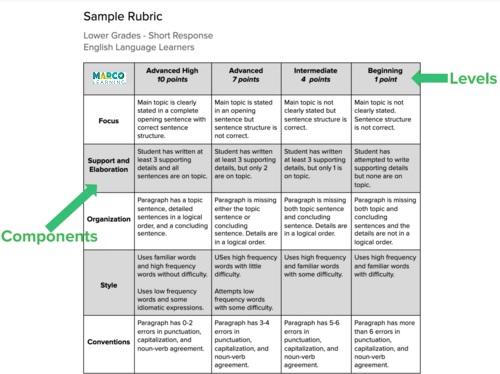
A RUBRIC REFRESHER
Rubrics provide a framework for helping students gauge the state of their writing (“level”) across different elements (“components”). The level descriptions for each component give meaning to the score and provide teachers and students with a common vocabulary for understanding the key expectations of the assignment.
Key characteristics of rubrics:
- Provides common language that serves as a basis for teaching and responding to student work
- Provides students with a consistent guide that focuses their skill and knowledge development over time
- Describes student performance in terms that allow for varied paths to success
Characteristics of Rubrics You Can Use with Marco Learning
- Analytic or holistic
- A description of what each level of attainment means for each rubric component
- A single numerical score for each level of attainment (no range scoring)
- No more than 5 rubric components (AP College Board rubrics excluded)
- No more than 10 levels (ideally 3-5 levels)
- No undefined half-points (i.e., Graders cannot assign point values between the levels described on the rubric.)
- No check-list style rubrics (i.e., Readers should not be asked to count conventions errors or the number of quotes used. Rubrics should not contain a list of “all or nothing” requirements without further detail.)
Please note, the Marco Learning Team will provide alternatives for rubrics that do not meet the above requirements to teachers.
Why all the rules?
At first blush, more flexible approaches make tremendous sense. Rubrics, however detailed, are simplified. In reality, “writing scores fall along a potentially infinite continuum of score points” (Smith & Swain, 2017, Assessing Writing, Teaching Writers). Half points are one step closer to representing reality.
Rubrics bucket that continuum into a limited number of available actual scores. As Jorge Luis Borges concisely noted in his story “On Exactitude in Science”, a life-sized map is useless to anyone trying to get around. As Graders navigate your students’ essays, they will notice minute differences among even closely adjacent papers on the continuum. But they must ultimately assign scores.
At Marco Learning, we have two key reasons for not allowing Graders the freedom to assign scores in between levels.
- Independent scorers. Clear and specific rubrics are foundational for consistency between and among Graders . Graders rely on the rubric descriptors to make decisions about where a paper lies for any given component. If the number of options suddenly expands to include half-point scores but offers no description of what a half point represents, Graders are left with heightened ambiguity in their decision making (more options but no more information) and student and teachers are left guessing as to the meaning of the half point delta.
- Our technology translates your rubric into a clickable scoring tool for Graders . If a level does not exist on your rubric, it cannot become a level in the system for the Grader to select!
A WORKAROUND
Rubrics are living tools that can be adapted to the intricacies of your instruction. If your assignment requires a finer distinction between scores than the existing rubric levels permit, simply adapt your rubric. You can create a more detailed rubric with more levels as long as you provide descriptions of what each additional level means. The Marco Learning Grading Ops Team can also offer alternatives from our rubric library.

 Help
Help